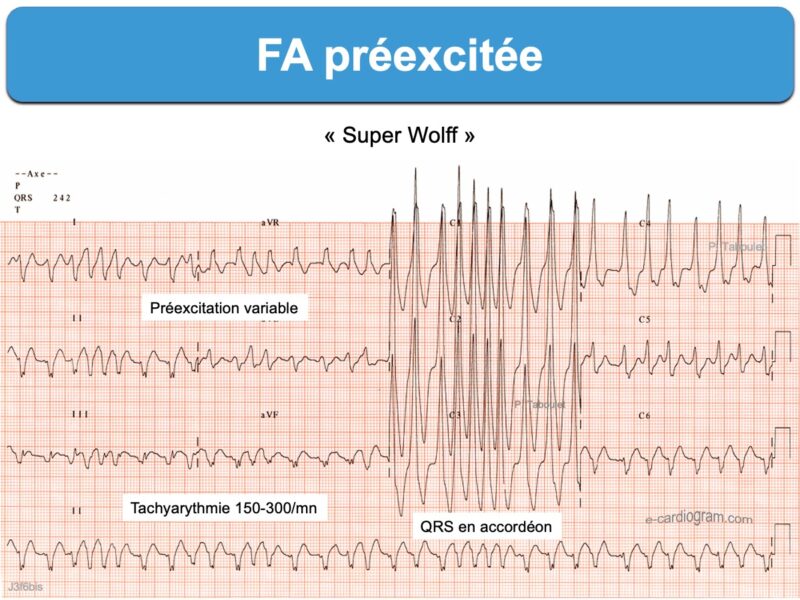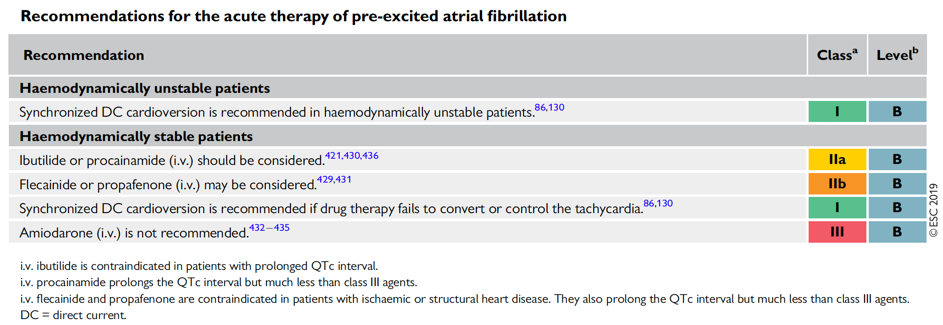Lorsqu’une FA est conduite à un ventricule par un faisceau accessoire perméable dans le sens antérograde (cf. Conduction antidromique), la cadence ventriculaire peut être extrêmement rapide, dégrader l’hémodynamique et se compliquer de fibrillation ventriculaire et mort subite (cf. FA et préexcitation).
La Société européenne de Cardiologie a proposé en 2019 des guidelines de prise en charge [1].
- En cas d’instabilité hémodynamique, une cardioversion/défibrillation électrique doit être entreprise (Classe I).
- Si l’hémodynamique est stable, une cardioversion pharmacologique peut être entreprise. Elle repose sur un antiarythmique par voie intraveineuse comme le/la flécaïnide-propafénone (classe IIb) en l’absence de cardiopathie structurelle ou bien l’ibutilide ou le procaïnamide* (classe IIa) mais non disponibles en France [1].
Flécaïnide
IV : 2 mg/kg en 10-20 min sous monitoring. Efficacité en moins d’une heure. Contrindiquée en cas d’insuffisance VG et cardiopathie ischémique. Risque de flutter quinidinique [1] .

Pour éviter une accélération iatrogène de la fréquence, il est interdit d’utiliser les médicaments qui raccourcissent la période réfractaire des myocytes, empêchent la conduction cachée ou pourraient faire chuter la pression artérielle (adénosine, inhibiteurs calciques, bêtabloquants, digitalique, amiodarone) (ESC 2019, Classe III)
L’amiodarone n’est plus recommandée ou avec prudence [2].

Le traitement préventif des formes symptomatiques sévères ou à risque de mort subite repose sur les méthodes ablatives (classe I). Le traitement préventif des formes peu sévères à long terme repose une prévention de la FA par sur la propafénone ou amiodarone [1] .
[1] Hindricks G, Potpara T, Dagres N, et al; ESC Scientific Document Group. 2020 ESC Guidelines for the diagnosis and management of atrial fibrillation developed in collaboration with the European Association of Cardio-Thoracic Surgery (EACTS). Eur Heart J. 2020 Aug 29:ehaa612. doi: 10.1093/eurheartj/ehaa612. Epub ahead of print. PMID: 32860505. Patients withWolff-Parkinson-White syndrome and AF are at risk of fast ventricular rates resulting from rapid conduction of atrial electrical activity to the ventricles via the accessory pathway, and at increased risk of ventricular fibrillation and sudden death. Electrical cardioversion should be readily available for haemodynamically compromised patients with pre-excited AF, and atrioventricular node-modulating drugs (e.g. verapamil, beta-blockers, digoxin) should be avoided. Pharmacological cardioversion can be attempted using ibutilide, whereas AADs class Ia (procainamide) and Ic (propafenone, flecainide) should be used with caution owing to their effect on the atrioventricular node. Amiodarone may not be safe in pre-excited AF as it may enhance pathway conduction.
[2] Brugada J, Katritsis DG, Arbelo E, et al; ESC Scientific Document Group. 2019 ESC Guidelines for the management of patients with supraventricular tachycardia. The Task Force for the management of patients with supraventricular tachycardia of the European Society of Cardiology (ESC). Eur Heart J. 2019 (téléchargeable)
